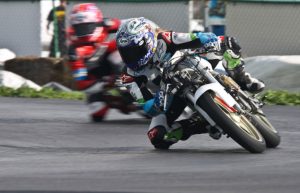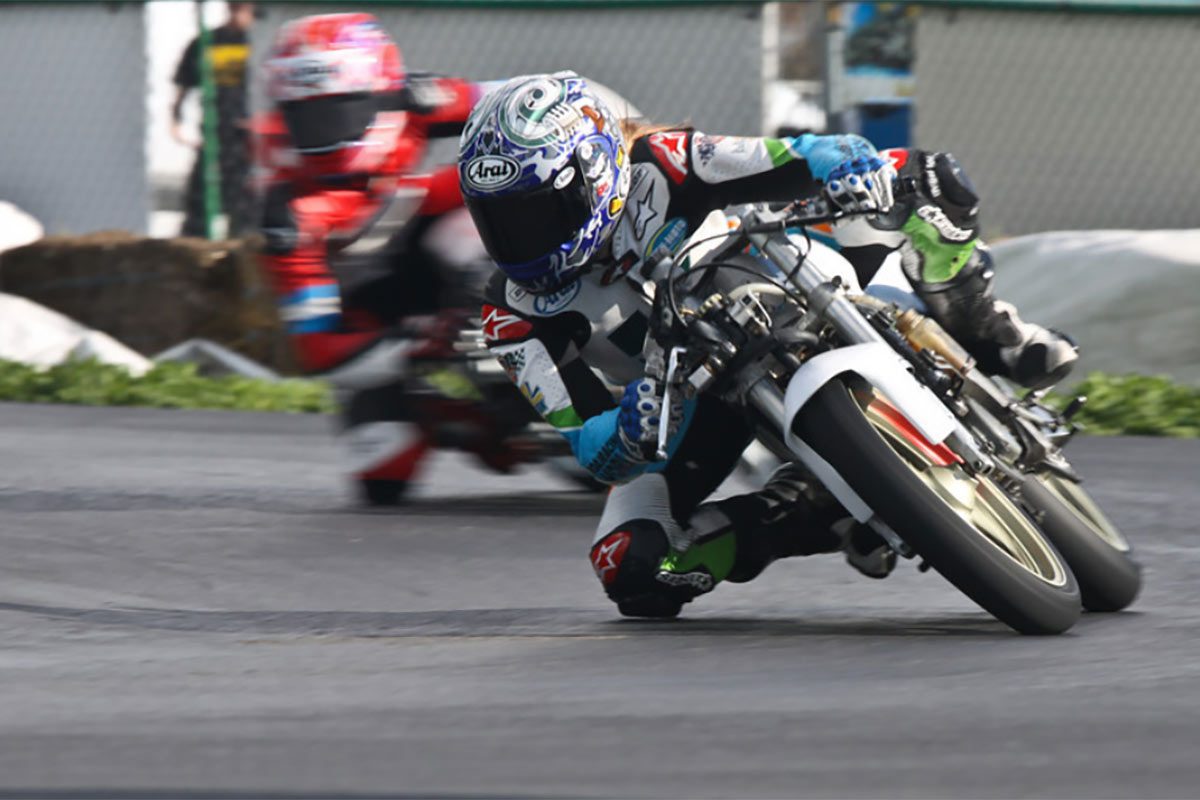
As a beginner at my local go-kart track and safety was always important to me. You can see me here riding with a full leather suit, gloves, boots and an Arai helmet on. Even at low speeds, my gear saved me countless times
In my previous post, I wrote about what a track day is: Simply the best way for the average motorcycle rider to get into the sport of roadracing. The time and expense of doing a track day can seem a little daunting at first, but when you consider the amount of quality time you get on your motorcycle, some of it with an instructor, it starts to seem a bit more reasonable. The key to getting the most value is coming prepared. Here’s a breakdown of how to make the best of your day at the track.
Safety first!
Whether you’re a beginner or professional, safety always comes first. There will be a safety inspection that is required for everyone before getting on the track. To make sure you pass, it’s a good idea to find out from the track day provider what they require from a motorcycle and rider safety standpoint.
For your motorcycle, you will generally need to tape up your headlights, taillights, and blinkers, make sure your brakes are functioning properly, your throttle is smooth and doesn’t stick, and that everything is tight–especially your oil drain plug, axles and brake calipers. If you don’t have the tools or knowledge to check these things yourself, take your bike to a local shop and have them check it over for you. Do this a week or more in advance so there’s less risk of getting stressed out, or worse, making a mistake.
For riding gear, most track day providers require you to have the following: an undamaged full-face helmet with visor, a full leather suit, motorcycle riding boots (preferably mid-calf), leather motorcycle gloves that overlap the arms of the suit, and a back protector. It’s also highly recommended, if not mandatory, to have full, comprehensive medical health insurance.
Although not required, I would also suggest transporting your motorcycle to the track in the back of a truck or trailer. That way you have some extra room to bring some items that will make your day more comfortable and enjoyable. And in the event something happens to your motorcycle at the track or on your way there, you won’t have to get towed home. The best item to bring: a friend or family member to give you some extra help, and be there in case of an emergency.
Basic equipment
Now that you have a good idea of how to get yourself and your bike ready for a track day, here is a list of some basic things you’ll need whether you ride to the track or transport your bike.
- Basic Tools: Tire pressure gauge, air pump, screwdrivers, wrenches, pliers, and scissors
- Duct tape and zip ties
- Water and electrolyte replacement (Pedialyte and coconut water are my favorites)
- Lunch and snacks
- Keys! (Trust me, I’ve seen it happen and have done it myself)
- Ear plugs to cut wind so you can hear your engine better
If you are transporting your bike, consider also bringing the following:
- Cooler with as much water and electrolyte replacement as you can fit
- Pop-up canopy and chairs so you have a cool place to relax between sessions
- Spare parts like levers and pegs
- Fuel jug, preferably a filled five-gallon can
- Ramp to get your motorcycle in and out of the transportation vehicle
Preparation timetable
Now that you know what you need, here’s a breakdown of the time leading up to your track day
1 week before:
- Make sure your bike is track-ready
- Get all your riding gear in good working order
- Make a checklist of everything you plan on bringing
3 days before:
- Start hydrating! You will lose a lot of fluid through sweat, and drinking just on the day of riding isn’t enough. 8 glasses a day will suffice.
- Stock up on beverages and food you would like to take
1 day before:
- Get everything together that you are taking. If you can load everything into your trailer or truck and keep it in a secure area, this is preferred. If not, make sure you have everything in one area so it’s easy to load in the morning.
- Get to bed early so you can get a good night’s sleep. You’ll be up early the next morning, especially if you have to load up and drive!
The big day!
The day starts with a rider’s meeting, usually at 8 a.m. Plan to arrive about an hour beforehand so you have time to unload and set up, register, go through the safety inspection, and prepare your bike and yourself for a great day. Here’s what I suggest:
- Fuel up your bike and set the tires to recommended pressures. If you’re unsure of what those may be, ask the vendor who sells tires and they should be able to point you in the right direction. If there is no vendor, ask the track day staff for advice.
- Go over your bike one more time to make sure everything is tight
- Do some basic stretches. Your body will thank you later.
- Riding usually begins at 9AM so listen for your group to be called over the loudspeakers. They’ll give you a five minute heads-up, and at this time make sure you have all your gear on properly, that your helmet is tight, gloves are fastened and mind is clear.
- After you get back in from your first session and your bike is on the stand, get your suit unzipped, drink a bottle of water and relax while waiting for the next time out.
- Try to have small snacks throughout the day and a moderate lunch. You don’t want to get too full but you’ll need the energy.
- Don’t forget to fuel up your bike throughout the day. You’ll be surprised how quickly your bike burns gasoline at wide-open throttle!
- After you’ve had a glorious day at the track, ask a friend or fellow rider to help load up your motorcycle, especially if it’s into the back of a truck click resources. You won’t realize how tired you are until you’re half way up the ramp and realize your strength has been zapped!
- Drive safely on your way home. Riding fast all day can get you revved up to drive fast on the way home, so keep your eye on the speedometer. Or, ask your companion to drive.
- Make sure you get some good protein in that evening to help your muscles recover. You’ll be sore the next few days in places you never knew existed!
I hope some of these tips can help make your track day a success. Most importantly remember to have fun! And after all, that’s why you’re there!

